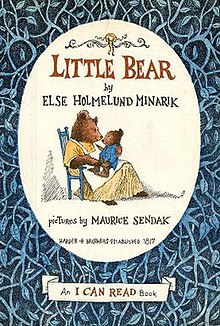Little Bear (book)
 Little Bear, 1st ed., cover art | |
| |
| Author | Else Holmelund Minarik |
|---|---|
| Illustrator | Maurice Sendak (1–5) Dorothy Doubleday (6) |
| Country | United States |
| Language | English |
| Genre | Picture book |
| Publisher | |
| No. of books | 6 |
Little Bear is a series of children's books written by Else Holmelund Minarik and primarily involving the interaction of Little Bear, an anthropomorphic cub, and Mother Bear, his mother.[1] The first book in the series, titled Little Bear, was published in 1957 by Harper and Brothers. It is an ALA Notable Children's Book.[2]
This series of books went on to spawn a TV series, Little Bear, which culminated with a direct-to-video film[3] entitled The Little Bear Movie.[4] The series was animated by Canadian studio Nelvana and starred Kristin Fairlie as the voice of Little Bear.[5]
The five original Little Bear books were illustrated by Maurice Sendak. In 2010, two years before her death, Minarik published a sixth book, Little Bear and the Marco Polo, which was illustrated by Dorothy Doubleday.[6][7]
Little Bear books
- Little Bear (1957)
- Father Bear Comes Home (1959)
- Little Bear's Friend (1960)
- Little Bear's Visit (1961)
- A Kiss for Little Bear (1968)
- Little Bear and the Marco Polo (2010)
Audiobooks
In 1996 British actor Peter Sallis best known as the voice of Wallace from Wallace & Gromit narrated two audiobooks from the Little Bear book series those being Little Bear and Little Bear's Visit.[8][9]
References
- ^ Reynolds, Anna K. (March 5, 2021). "Books Worth Reading: Else Holmelund Minarik's Little Bear series". Inspire Virtue. Retrieved October 16, 2023.
- ^ "Little Bear (I Can Read Level 1) | Breakwater Books". breakwaterbooks.net. February 18, 2003. Retrieved July 12, 2024.
- ^ Lechner, Ernesto (May 26, 2000). "'Bear's' Cozy World Draws in Toddlers". Los Angeles Times. Retrieved October 16, 2023.
- ^ ""Little Bear" a parent's savior". The Denver Post. April 23, 2007. Retrieved October 16, 2023.
- ^ Brennan, Patricia (September 10, 1995). "'Little Bear' Cuddles Up to Kids". The Washington Post. Retrieved October 16, 2023.
- ^ Fox, Margalit (July 13, 2012). "Else Holmelund Minarik, Author of Little Bear Books, Dies at 91". The New York Times. Archived from the original on December 29, 2022. Retrieved October 14, 2023.
- ^ Langer, Emily (July 18, 2012). "Else Holmelund Minarik, 91, was author of the 'Little Bear' pictures books". The Washington Post. Archived from the original on November 18, 2020. Retrieved October 14, 2023.
- ^ "Little Bear". book-info.com.
- ^ "Little Bear's Visit". book-info.com.